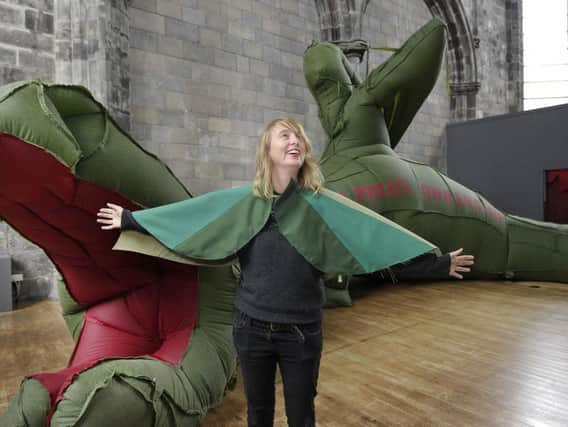Giant dragon to tour Royal Mile in Festival curtain-raiser


Two leading artists are to stage a performance with the inflatable creature in the heart of the High Street, which will be thronged from street performers from next week.
Around 40 primary schoolchildren will join the parade between the thoroughfare and the remains of a 15th century church building, where the dragon will be on display throughout August.
Advertisement
Hide AdAdvertisement
Hide AdZoe Walker and Neil Bromwich’s project has been inspired by the 100th anniversary of a manifesto by town planner Sir Patrick Geddes, who led efforts to revive the Old Town as a place to live.
Walker and Bromwich , who are renowned for their large-scale sculptural works, say they want to raise questions on how to “slay the dragon of profit and private ownership.” Their event will be staged just weeks after heritage experts warned that “commercial over-exploitation” of the city centre was posing a serious threat to the “authenticity” of the Edinburgh World Heritage site.
Actor Tam Dean Burn will be joining the two artists on the High Street from 2pm today to perform a show inspired by pageants staged by Geddes himself. The dragon will then be on display inside Trinity Apse, part of a gothic kirk which was relocated to Chalmers Close, off the High Street, to make way for the expansion of Waverley Station in the 19th century.
It is one of several corners of the Old Town being opened up to the public for the Edinburgh Art Festival. Others include an urban wildlife reserve on Johnston Terrace, the former home of Geddes in Ramsay Garden, and Gladstone Court, the site of an asylum for “young girls or fallen women who have deviated from the path of virtue and peace.”
Bromwich said: “The dragon motif is inspired by an image from a banner carried by Northumberland mine workers in the 1920s, which was basically a call for mines to be nationalised, and Geddes’s quote about ‘by leaves we live.’
“They will be fused together in the procession of green-leaves and eco-inspired pageantry, inspired by Geddes’s own eco-anarchism and love of pageants. We’ll perform right outside the Fringe box office, where the buskers normally perform. A lot of visionary ideas have been assimilated by corporate money. There are monolithic corporations that kind of control everything. I think there is a real reawakening at the moment, with people asking how we can live in better ways as a society.”
Walker added: “There are very important debates happening about the distribution of wealth in Britain. Edinburgh is becoming a really expensive place to live, particularly in the city centre, so it’s very relevant here.
Advertisement
Hide AdAdvertisement
Hide Ad“But we’re also really interested in the original vision for the Edinburgh International Festival that it could rebuild the human spirit after the war.”
Other special commissions lined up for the art festival, which runs until 27 August, include the installation of a pop-up studio workshop in a wildlife garden in the shadow of Edinburgh Castle.
Artist Bobby Niven’s “reimagined palm house,” which is said to have been inspired by the famous glasshouses in Edinburgh’s Royal Botanic Garden, will play host to four artists - Neil Bickerton, Alison Scott, Daisy Lafarge and Deirdre Nelson - who will be creating new work inspired by the location and the ideas of Geddes. Toby Paterson has created a new architectural installation in the form of a modern shelter for Chessels Court, one of a network of open spaces in the Old Town which Geddes helped inspire.
Gladstone Court, which was also once home to the Edinburgh Gaslight Company, is playing host to a new video installation by the New Zealand artist Shannon Te Ao, which will explore “the emotional depths of love, grief and healing.”
This year’s art festival programme has been inspired by both the 70th anniversary of the city’s cultural celebration and the Geddes manifesto, The Making of the Future.
Festival director Sorcha Carey said: “This year seemed like a really good moment to go back and cast a spotlight on Geddes and his contribution to Edinburgh. The artists we’ve commissioned this year are looking at this ideas, but are also largely working in spaces associated with him. He was a critical figure in the preservation of the Old Town as we see it today.”
FESTIVAL HIGHLIGHTS
The Edinburgh Art Festival, which is being staged for the 14th time, features 45 major exbibitions staged across 35 different venues.
Advertisement
Hide AdAdvertisement
Hide AdHighlights include a display of images captured during the Crimean War by the 19th century photographer Roger Fenton, which will be staged at Holyrood Palace.
Douglas Gordon has created a new black marble work of Robert Burns, which will lie in pieces in the great hall of the Scottish National Portrait Gallery, in front of the celebrated statue of the poet by John Flaxman.
The same gallery is featuring a revival of The Slave’s Lament, a show inspired by Burns’ poem, which reflected on his plans to leave Scotland to work overseeing slave labour on a plantation in the West Indies.
Inverleith House, the art gallery controversial closed down at the Royal Botanic Garden last year just months after its 30th anniversary, will be temporarily reopened for a major exhibition of work inspired by the 50th anniversary of the attraction’s modernist glasshouses.
The Dovecot Gallery will feature a celebration of female textile artists and the role of women in the textile industry, including showcases of work by Claire Barclay, Elizabeth Blackadder, Christine Borland, Hanna Tuulikki and Maureen Hodge.
The multi-media Age of Oil exhibition at the National Museum of Scotland is a showcase of work by Sue Jane Taylor drawn from more than 30 years recording the lives of workers in the North Sea oil and gas industries.